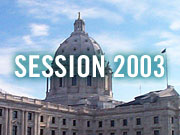Audio
More from MPR
Your Voice
| |||||||||||||||||||||||||||||||||||||||||||||||
Budget cuts scare social service providers
February 20, 2003
Social service providers are looking for ways to cope with funding cuts in Gov. Tim Pawlenty's budget. The governor's spending plan eliminates health insurance coverage for many people who are working, but poor. Some services will merge, and health care premiums for those who are covered will increase.
Moorhead, Minn. — Gov. Pawlenty plans to spend $8 billion on health and human service programs. That amount is an increase of 8 percent from the current budget. Health and Human Services Commissioner Kevin Goodno says it's much less than the 20 percent increase officials had planned for. He says rising health care costs are to blame.
Goodno says with money tight, all programs may face changes. He says with less state money available, participants will have to pay more. But the commissioner insists, the cuts shouldn't affect kids.
"What we are doing is continuing to provide health care, but we're asking people who are able-bodied -- we're not going after kids," Goodno says. "We're dealing with the adults and saying, 'You can afford to pay more of your premium.'"
|
What we are doing is continuing to provide health care, but we're asking people who are able-bodied. We're not going after kids.
- Health and Human Services Commissioner Kevin Goodno |
Goodno says state health care programs for undocumented residents have been eliminated. Emergency room care will still be available, but paid for by the federal government.
Programs like MinnesotaCare are also facing cutbacks. That health care program is a safety net for low-income people. It was created with the idea of helping those who slip through the cracks -- working people who don't qualify for welfare, but can't afford health insurance. Currently, 150,000 people have insurance through MinnesotaCare, and half of them are children.
"Under these proposed budget cuts, there would be 30,000 or more that would lose coverage," says Michael Scandrett, a health care attorney and consultant in Minneapolis.
Scandrett says the people who are forced out of MinnesotaCare will lose their coverage because they make too much money. To qualify, a family of four won't be able to make any more than $37,000 a year. Scandrett says premiums to continue coverage for both parents will cost more than $6,000 a year.
But those 30,000 people removed from MinnesotaCare will still need health care, especially since many of them will be children. Scandrett says the cost for their care will come from local taxpayers.
|
Under these proposed budget cuts there would be 30,000 or more that would lose (Minnesota Care) coverage.
- Health care attorney Michael Scandrett |
"They will do that (cover the price of coverage) either by subsidies from the local property taxes, or by increasing the rates that are charged to other paying customers who have insurance or who are paying on their own," says Scandrett. "So the cost then gets paid for by all the rest of us through higher property taxes and through higher insurance premiums."
And the bad news doesn't stop there for community health and social service providers. One example is the Mahube Community Council in Detroit Lakes, a community action group that runs social programs in three northwest Minnesota counties. Executive Director Leah Pigatti says money from the state comes in many forms, and some of their other funding sources are targeted, too.
"We lost 53 percent of the state funding for the Minnesota Economic Opportunity Grant. That grant is core funding for community action agencies, and that funding helps support families, many of them working poor families," says Pigatti.
She says that money helps low-income families pay the monthly premiums for their MinnesotaCare coverage. It's also a place for the working poor to get help with utility bills, or find a place to live. Pigatti says the cuts will also affect services designed to help people improve their lives.
"To (help people) develop a resume, maybe to go back to school and get their GED or go through adult basic education and improve their job seeking skills, so they are able to get a better job," says Pigatti.
Leah Pigatti says the budget proposals scare her. She's afraid the cuts will make it harder for the working poor to break out of the cycle of poverty.
|
News Headlines
|
Related Subjects
|

